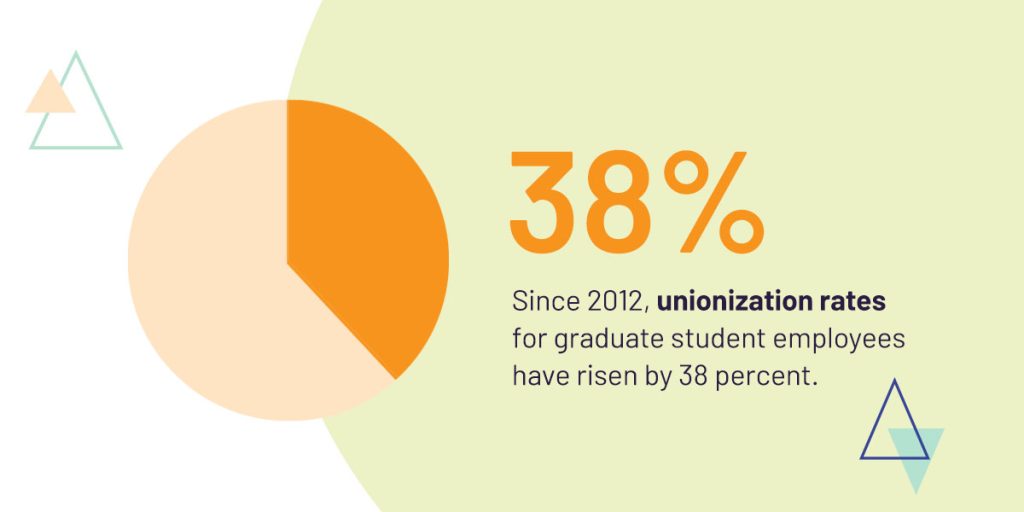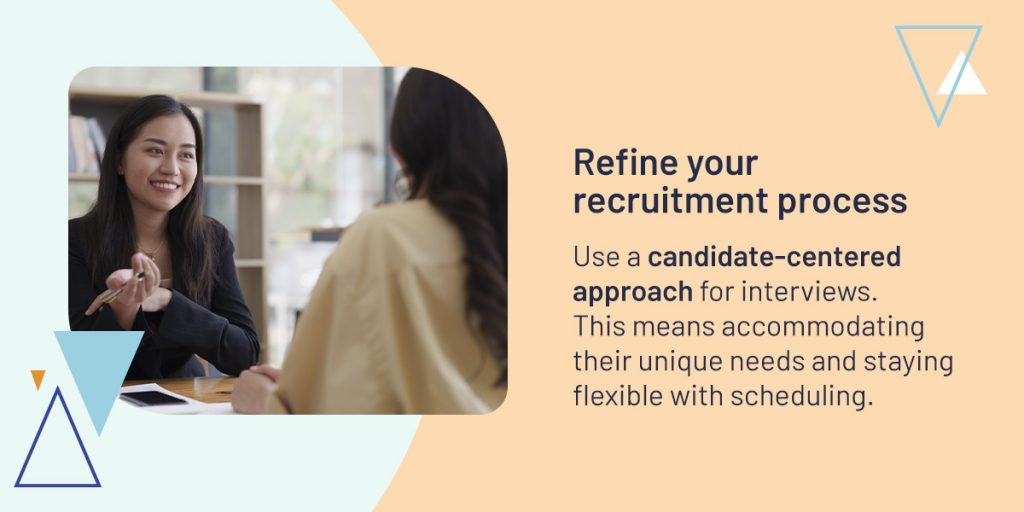




Faculty are the foundation of your institution. They’re responsible for creating and delivering innovative courses that inspire and engage students. With happy, thriving students, your institution’s reputation will grow. Faculty are also your best tool to tackle the challenges facing higher education institutions today. From declining enrollment rates, rising education costs, and emerging alternatives to studying, talented faculty are a necessity. But how do you attract them to your institution? Better yet, how do you make them stay in today’s educational climate?
Higher education faculty across the country are feeling increasingly unsatisfied with their jobs, prompting many to seek better jobs elsewhere. One of the major factors affecting faculty retention today is the lack of tenure. Many institutions are choosing to keep primarily non-tenure track staff. Without awarding tenure, higher education institutions may make their faculty members feel less appreciated and insecure in their jobs. Job security can negatively affect faculty morale and performance, and employee turnover may rise.
Recently, more faculty members have been pushing to unionize. Since 2012, unionization rates for graduate student employees have risen by 38 percent. By forming a union, faculty have the power of collective bargaining to advocate for job security and better salaries.

Now more than ever, institutions need to invest in their faculty to ensure their happiness and the longevity of the institution as a whole.
Hiring and retaining qualified faculty is vital to higher education institutions. It impacts:
Your institution’s educational quality is dependent on your faculty. Professors with more experience can teach more effectively and make learning engaging. With higher education costs rising by as much as 40 percent over the past two decades, students have higher expectations for their education. They want to know they’re getting what they pay for, which is why having qualified faculty is essential.
Recent decreases in enrollment rates have been a serious challenge for higher education institutions. While enrollment is slowly on the rise again, institutions should still focus on attracting and keeping students. One of the best ways to achieve this is by retaining top faculty, as students often prioritize attending institutions with a high standard of education. Faculty play a large role in shaping educational quality.
Since student performance is considered one metric for measuring institutional quality, retaining quality staff should be a top priority. Top talent can raise enrollment rates, student retention, academic achievement, and graduation rates. As your institution’s academic reputation grows, more students will want to enroll. Student success rates can also increase your institution’s chances of receiving government funding.
There are multiple effective strategies you can use to attract and retain top talent. You can try a combination of tactics to increase your chances of finding the best people for the job. Once you have them on board, ensure your institution does everything it can to make working there a great experience.
Below are 10 strategies you can add to your faculty hiring plan.
An effective way to attract experts to teach at your institution is to grow brand awareness, which refers to how familiar people are with your institution and its values. Increased brand awareness can help you create a strong reputation and build trust in the industry. This is important when trying to attract educators, as it will help your institution stand out from the competition.
Take advantage of these tactics to increase brand awareness:
Your institution’s facilities can also help attract top talent. Faculty spend every day on campus, so it makes sense that they consider it before accepting a position. If you’re working on a limited budget, start by improving lecture halls. Ensure they are well-maintained, clean, and equipped with the latest educational technology.
Research centers and laboratories are another place to focus improvements. Give faculty access to the latest equipment so they can perform at their best and stay ahead of advancements. Create collaborative spaces where staff and students can work on projects together. An effective way to see what improvements will have the most impact is to ask faculty directly. They can provide feedback and highlight areas that need attention.

It’s easier to find the perfect match for your institution when you have a larger candidate pool. To increase yours, you’ll need to diversify your search. Putting the call for applications across as many channels as you can will greatly increase your chances of finding potential candidates. It also helps to directly reach out and offer positions to qualified candidates.
To diversity candidate search, you can:
Another effective way to attract top talent is to create detailed job descriptions. Adding as much information as possible will encourage only relevant candidates to apply. Each position’s description should offer a comprehensive overview to potential applicants.
Include only the most crucial qualifications and experience requirements for the job. Highlight the position’s roles and responsibilities to give candidates a clear idea of their day-to-day tasks. It’s also a good idea to emphasize your institution’s priorities and goals — the people who apply will hopefully have resonated with them. Finally, ensure all language is inclusive and devoid of bias. Remove any gendered language, stereotypes, and outdated terminology.
The choice between one job offer and another often comes down to compensation. To hire top faculty, you need to offer competitive pay and benefits. Market research is vital to determining the standard industry rate for a position. When you offer a similar or higher rate, you show candidates you value their skills and contributions.
Competitive pay can also contribute toward job satisfaction and retention. Studies show salary is one of the strongest reasons faculty leave. However, pay is just one part of a competitive compensation package. The best candidates tend to expect more than standard benefits like retirement funds and health insurance. They’re seeking things like flexible schedules and ample paid leave so they can maintain a healthy work-life balance. You can also offer transportation allowances, student assistants, on-campus living quarters, a private office, and family discounts. Benefits like these can make a huge difference if you’re unable to offer a competitive salary.
Across most industries, workers state that a lack of growth opportunities makes them want to quit their jobs. If there’s no internal path for career advancement, it’s easy to feel stagnated and bored. Faculty may also begin to feel undervalued. By creating a clear career pathway, you can influence faculty to stay loyal to your institution.
It’s also beneficial to provide personal growth opportunities. Invest in your staff and support their continued education by offering additional training and workshops.
Improving your recruitment process is essential to attracting top talent. A streamlined, straightforward, and positive process will give candidates a good impression of your institution. They may even recommend it to others looking to apply. The process starts as soon as you receive an application.
Ensure you have a timeline in place so you can keep them informed of the next steps. Clear, consistent communication is integral to creating a positive experience. Even if their application is unsuccessful, offering feedback provides a better impression of your institution.

Use a candidate-centered approach for interviews. This means accommodating their unique needs and staying flexible with scheduling. Additionally, each interview or campus visit should have an organized schedule to show your respect for their time. The goal is to make candidates feel welcome and valued at all points of contact.
A supportive onboarding process is an effective strategy for retaining new faculty members. Onboarding is all about introducing and integrating faculty into their roles and the institution’s culture. You want each person to feel welcome, and a less stressful start will give them the space they need to acclimate and find their footing.
Effective onboarding starts with personally showing new hires around campus. You can introduce them to their department and give members a chance to connect. Provide them with all the information and resources they need to succeed in their first few weeks. You can also assign them a mentor for individualized assistance and support.
Diversity and inclusion in the workplace create a culture where everyone feels valued and accepted. Employees who feel this way are happier, more productive, and less likely to leave. Culture plays a significant role in attracting top talent. Experts want to work in an environment that supports them. Focusing on diversity will form a positive brand reputation for your institution, which can make it more appealing to potential faculty.
Another benefit of a diverse and inclusive culture is that it will enlarge your talent pool. Bias during the hiring process can limit the amount of people who feel they can apply. When you use inclusive language in job descriptions, you’ll have access to a wider range of professionals. They’ll bring their unique perspective and talents to help your team cater to various student needs.
The people you choose for your application search committee also matter. They’re responsible for overseeing the recruitment process, including creating job descriptions, reviewing applications, and conducting interviews. Establishing a diverse committee that values inclusion will ensure they choose the best applicants for the role, no matter their background. You can also put faculty through training programs and workshops so everyone has the tools to address discrimination and unconscious bias.
In your quest to find top talent for your institution, it can be easy to fall into the trap of credentials. Yes, a candidate’s experience and education are important to consider. However, personality and personal values can make a big difference in faculty retention. Hiring based on skill alone can lead to a poor culture fit. They might disrupt the culture and cause other faculty members to feel dissatisfied. The new hire may also feel excluded or frustrated.
Consider your institution’s current culture to determine who would be a good fit. Look at working style, company values, management approach, and employee expectations. Express this culture in hiring materials to ensure candidates get a feel for it before applying.
While it’s important to find a good fit, ensure you’re not hiring similar people every time. Having a diverse faculty with various skills and personalities can lead to more creativity and innovation. The new hire should fit right in with the existing faculty but bring a fresh perspective.

The best way to support employees and ensure their happiness is to consistently request feedback and review their progress. However, collecting and organizing this data can be difficult without the right tools. At Watermark, it’s our mission to help you simplify and automate data collection so you can focus on what matters most.
To help you support your team, we created Watermark Faculty Success. This innovative software captures faculty accomplishments in one central hub. You can use this data to update and share faculty CVs and web profiles. It’ll also help you report faculty credentials for accreditation and streamline review, promotion, and tenure processes. With Faculty Success, you’ll glean deeper insights into faculty contributions so you can provide feedback and support their growth.
Want to see what Faculty Success can do for your institution? Request a live demo today.
























































































































































































































































































































































































Submit this form to schedule a meeting with one of our reps to learn more about our solutions. If you need customer support instead, click here.